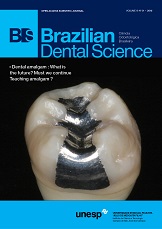Prevalence of malocclusion and orthodontic treatment needs among down syndrome sudanese individuals
DOI:
https://doi.org/10.14295/bds.2015.v18i1.1076Resumo
Objective: To determine the prevalence of malocclusion and orthodontic treatment needs in Sudanese’s Down syndrome individuals in Khartoum area. Material and Methods: A total of 75 (37 males and 38 females) Down syndrome individuals age ranging from 6-28 years of age, were clinically examined after obtaining their guardian’s consent. Malocclusion was determined based on Angle and Incisor classification of malocclusion. The data were analysed and presented in tables using the Statistic Package for social sciences (SPSS) program version17 descriptive statistic, Frequency distribution tables and graph were utilized to perform the results. Results: Angle Class III malocclusion (58.7%) and Incisor III malocclusion (53.3%) represents the most prevalent types of malocclusions. Angle class III malocclusion was more frequent among females (60.5%) than males (56.8%).The majority of individuals with Down syndrome are in great need for orthodontic treatment (85.3%). Conclusion: The prevalence of malocclusion and orthodontic treatment need among Sudanese Down syndrome individuals was high. Angle and Incisor class III malocclusions represent the commonest trait of malocclusion and reported more frequency in females than males. Orthodontic treatment for Down syndrome individual should be multidisciplinary in order to conservative superior treatment pattern.
Keywords: Down syndrome; Class III malocclusion; Orthodontic treatment.
Downloads
Downloads
Arquivos adicionais
Publicado
Como Citar
Edição
Seção
Licença
TRANSFERÊNCIA DE DIREITOS AUTORAIS E DECLARAÇÃO DE RESPONSABILIDADE
Toda a propriedade de direitos autorais do artigo "____________________________________________________________________" é transferido do autor(es) para a CIÊNCIA ODONTOLÓGICA BRASILEIRA, no caso do trabalho ser publicado. O artigo não foi publicado em outro lugar e não foi submetido simultaneamente para publicação em outra revista.
Vimos por meio deste, atestar que trabalho é original e não apresenta dados manipulados, fraude ou plágio. Fizemos contribuição científica significativa para o estudo e estamos cientes dos dados apresentados e de acordo com a versão final do artigo. Assumimos total responsabilidade pelos aspectos éticos do estudo.
Este texto deve ser impresso e assinado por todos os autores. A versão digitalizada deverá ser apresentada como arquivo suplementar durante o processo de submissão.




























